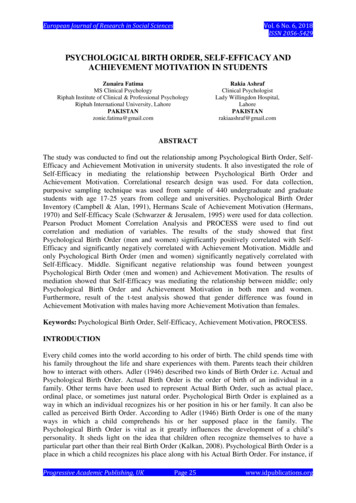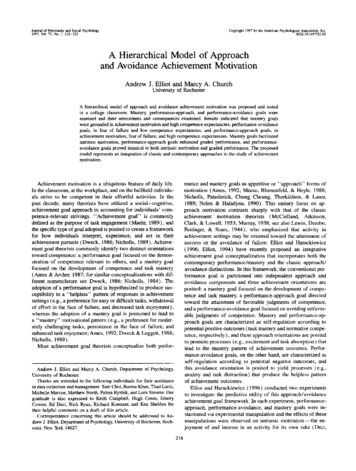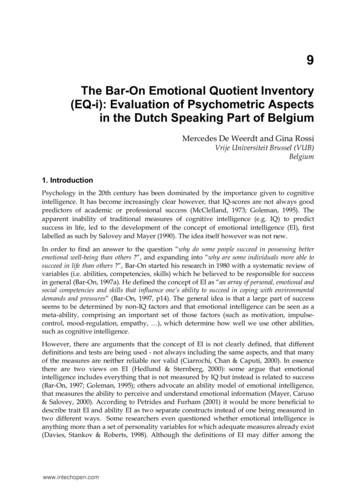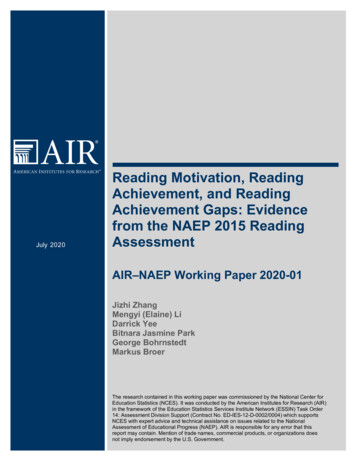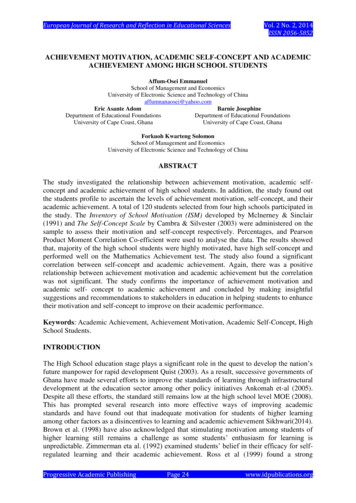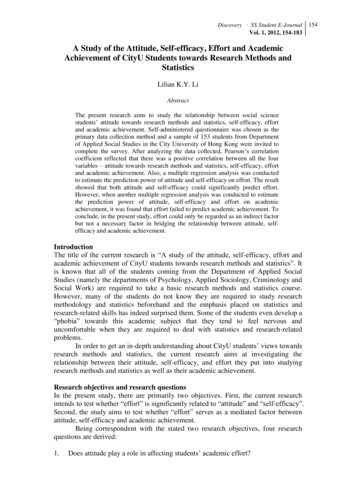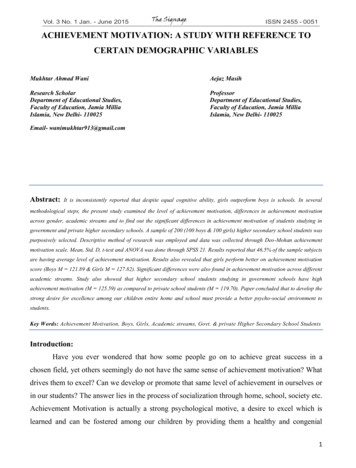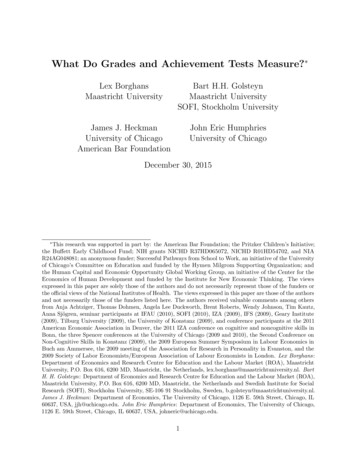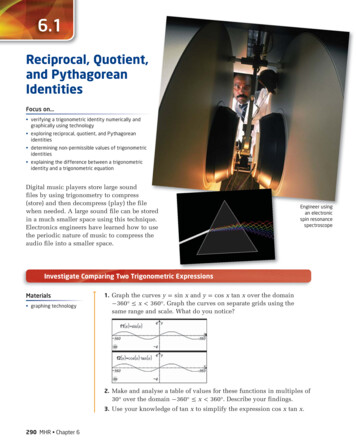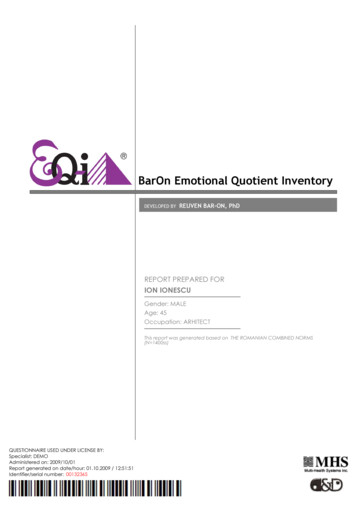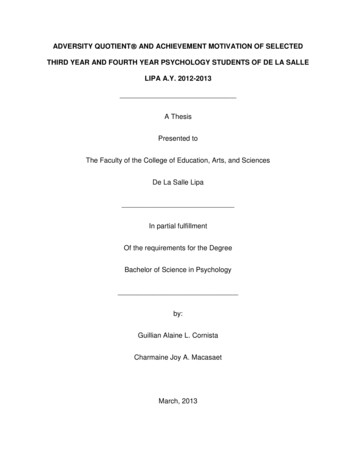
Transcription
ADVERSITY QUOTIENT AND ACHIEVEMENT MOTIVATION OF SELECTEDTHIRD YEAR AND FOURTH YEAR PSYCHOLOGY STUDENTS OF DE LA SALLELIPA A.Y. 2012-2013A ThesisPresented toThe Faculty of the College of Education, Arts, and SciencesDe La Salle LipaIn partial fulfillmentOf the requirements for the DegreeBachelor of Science in Psychologyby:Guillian Alaine L. CornistaCharmaine Joy A. MacasaetMarch, 2013
ABSTRACTTHE ADVERSITY QUOTIENT AND ACHIEVEMENT MOTIVATION OF SELECTEDTHIRD YEAR AND FOURTH YEAR PSYCHOLOGY STUDENTS OF DE LA SALLE LIPA A.Y.2012-2013The major focus of this study was to investigate the Adversity Quotient andAchievement Motivation of selected third year and fourth year psychology students of De LaSalle Lipa AY 2012-2013.Ninety (90) psychology students were included in this study through purposive samplingtechnique. The major instrument used in the assessment of the adversity quotient of therespondents was the AQ Profile and for achievement motivation was the AchievementMotivation Profile. The profile variables of the respondents were also investigated to find out iftheir adversity quotient and achievement motivation would be influenced by such factors.SPSS computer software was utilized in the calculation of the research data, the resultfound out that there was no significant relationship between the adversity quotient and theprofile of the respondents. However, the researchers found that there is a significant relationshipin the ownership dimension of adversity quotient of the respondents when grouped accordingto year level. There was no significant relationship between the achievement motivation and theprofile of the respondents. Lastly, the results of the Pearson product moment correlation(Pearson r) showed there is a significant relationship between the overall adversity quotient and each of the domains under achievement motivation of the respondents in this study.The present study concludes that the adversity quotient and achievement motivationhas a relationship. However, not all the dimensions of adversity quotient were found toinfluence the achievement motivation of the respondents in this study.
DEDICATIONWords are not enough to express how grateful we are to our families and loved oneswho gave inspiration, support, and love.Our friends, classmates and instructors, who have been the source of perseverance. Toall of those involved while doing this study who have shown their cooperation and trust.And most of all, to the Heavenly Father, who gave us the strength, and hope in thesuccess and realization of this paper.CharmaineGuillian
ACKNOWLEDGMENTThe researchers would like to express their sincerest gratitude and warmestappreciation to the following persons for extending their support that made this studysuccessful.To Mr. Arvie S. Andal, thesis adviser, for his time, patience, guidance andsupport in the completion of this paper. Thank you for sharing your knowledge andideas in the field of Psychology. Thank you for everything you have done for usespecially whenever we approached you when there is a problem.To Mr. Darwin C. Magpili, teacher in charge, for his comments, suggestions andhis patience in accommodating our questions when we are in trouble. Thank you foryour guidance when we are confused.To Mr. George T. Mesada, Area Chair, for his patience, support, encouragementand advice to be humble and patient in every situation that would come to our lives.Thank you also for allowing us to conduct our data gathering in one of your class andfor signing all of our transmittal letters.To Ms. Ivee Guce, statistician, for her assistance in statistics and her explanationfor each form we used.To Dra, Amparo K. Sabandal, a former Psychology Department Faculty Member,for her care and concern. Thank you for giving us the courage to be humble, trustingthat this study would be possible, and believing that this study would be accomplishedwork.
To Ms. Romaine G. Magboo, professor Psychology Department, for allowing usto conduct our data gathering in one for her classes, and for giving us suggestionsespecially when we are confused while we are looking for a test best suited for ourstudy.To Ms Fe Balani and Mercedes Malabanan, guidance counselor, foraccommodating our questions, their patience and advice especially when we need helpin times of trouble for the test needed for this paper.To Gian Emmanuel Uy, a special friend, for his time, patience and whole-heartedhelp and sincerity for helping us in everything, especially when we are encoding thedata gathered. Thank you for your utmost support for us.To our dear friends in 3rd year and 4th year Psychology major, for their warmthsupport and willingness to help while conducting our data gathering.To our fellow Psychology major, who have been the respondents for thisresearch, for their time, patience and willingness to answer both questionnaires beingused. Without your cooperation, this study would not be possible. Thank you very much!To all the people we failed to mention here, who have helped us in one way oranother in making this paper better, we thank you all very much!To the researchers' parents, for the whole-hearted support and unconditionallove they have shown while having the research and completion of the study.Above all, to Almighty God, for giving us the strength and perseverance neededto surpass the hardships encountered in doing the course of research.
Chapter 1BACKGROUND OF THE STUDYIntroductionLife gives you the ability to fulfil your inner purpose even if struggles occur. Likestudents, they encounter numerous adverse situations at home and in school. Becauseof this, students should know their capacity to deal with the adversities of their lives.According to Brunkhorst, adversities are a part of living, and people choose theway they react to each adversity in our lives. Many times it will be senseless, unfair,painful, and beyond our control to prevent. However, it comes into our lives for areason. They can choose to learn valuable lessons from each adversity we encounter.The more difficult the adversity, the more valuable will be the lessons it offers (2005[online]).There are various issues and problems that adolescents may face in theturbulent times of their teen years. An adolescent feels all kinds of pressures - fromparents, school and peers. They are in a transitional period where they are moving fromchildhood to adulthood (Problems of children & teens, [online]). Life for manyadolescents is a painful tug of war filled with conflict demands from parents, teachers,friends, coaches and oneself. It can create hardship, stress, and serious depression topeople who cannot cope, communicate, or solve problems. More so, it can affect theirmotivation to succeed.
Achievement motivation is a widely researched topic in both the fields ofpsychology and education. Achievement motivation can best be understood byexamining the meanings of “achievement” and “motivation” separately.Achievement typically stresses the importance of accomplishment andattainment with effort involved. Achievement can also be described as energy that isused to overcome challenges and persevere to conquer a goal. Motivation relates to anindividual’s reason for engaging in an activity, the degree to which an individual pursuesthe activity and the persistence of the individual (Clark, 2010).Motivation is the basic drive for all individual’s actions. Motivation refers to thedynamics of their behavior, which involves their needs, desires, and ambitions in life.Achievement motivation is based on reaching success and achieving all of ouraspirations in life. Children with high achievement motivation seek out challenging tasksthat they know they can accomplish with effort and persistent. High achievers tend to bepersistent and hard work to attain goals they set for themselves (Briones, 2010).Achievement goals can affect the way a person performs a task and represent adesire to show competence. Our motives for achievement can range from biologicalneeds to satisfying creative desires or realizing success in competitive ventures.Motivation is important because it affects our lives everyday. All of our behaviors,actions, thoughts, and beliefs are influenced by our inner drive to succeed (Rabideau,2005 [online]).Adversity Quotient (AQ ) can help students in knowing how resilient they areand how they handle and manage their current situation as an individual with their ownpersonal lives and as students. AQ tells how well one withstand adversity and their
ability to surmount it. It also predicts who will overcome adversity and who will becrushed (Stoltz, 1997).It can be distracting when there are a lot of tasks to do. This is an example to theproblems that students are facing. One solution to that problem is to motivate them intheir studies. Motivation is the process whereby goal-directed activity is investigated andsustained. It also involves goals that provide impetus for and direction to action(Schunk, Pintrich & Meece, 2008). Both AQ and Motivation affectsthe performance ofthe person. It can show how resilient a person can be even if problems arise.Statement Of The ProblemThe main focus of this study is to find the results of the following:1. What is the profile of the respondents with regards to the following variables:1.1 age;1.2 gender; and1.3 year level;2. What is the level of Adversity Quotient in terms of:2.1 control2.2 ownership;2.3 reach;2.4 endurance; and2.5 overall AQ ;3. What is the Achievement Motivation of the respondents in this study in terms of:3.1 motivation for achievement;
3.2 inner resources;3.3 interpersonal strengths; and3.4 work habits;4. Is there a relationship between the Adversity Quotient of the respondents andtheir profile;5. Is there a relationship between the Achievement Motivation of the respondentsand their profile;6. Is there a relationship between the Adversity Quotient and the AchievementMotivation of the respondents?Statement Of The ObjectivesThe study aims to:1. Determine the profile of the respondents in terms of age, gender and year level;2. Acquire the level of Adversity Quotient of the respondents in terms of Control,Ownership, Reach, Endurance, and their overall AQ ;3. Identify the Achievement Motivation of the respondents in terms of Motivation forAchievement, Inner Resources, Interpersonal Strengths, and Work Habits;4. Find out if there is a relationship in the Adversity Quotient of the respondentsaccording to age, gender, and year level;5. Find out if there is a relationship in the Achievement Motivation of therespondents according to age, gender, and year level;6. Find out the relationship between the Adversity Quotient and the AchievementMotivation of the respondents.
Significance Of the StudyThis study aims to be beneficial to the following:For the RespondentsThis study would provide them a deep understanding on their AdversityQuotient and achievement motivation. It would also give awareness on therespondents’ level of AQ and achievement motivation based on the findings.Having these learned, it could give them knowledge on how they should respondand be motivated in facing difficult situations.For the Parents of the RespondentsThis study can give information on how resilient their children are. Thiscan serve as a guide of parents in motivating their children and giving moralsupport in overcoming adversities for a positive outcome.For the TeachersThe study will help the teachers provide encouragement and furtherunderstanding in order to know how students manages their problems.For Future ResearchersIt can guide them with the information written in this study. They will havelesser time in conducting the research since the study has been made and thisstudy can help them because it can add information for references.
Scope And LimitationThis study was limited to selected third year and fourth year Psychology studentswho are currently enrolled in De La Salle Lipa A.Y. 2012-2013. It focuses on twoimportant variables, the Adversity Quotient and Achievement Motivation. TheAdversity Quotient was measured through the AQ Profile instrument provided online by Dr. Paul G. Stoltz while the Achievement Motivation would be measured throughthe use of Achievement Motivation Profile (AMP).The study was conducted to the said respondents since most third year andfourth year students are facing more tasks and difficulties with their school workscompared with the lower year levels. Psychology students were chosen as respondentssince the researchers themselves are also taking up the same course. It would also bebetter if they will know first their own behavior towards this kind of situation beforeanalyzing the behavior of others.
Chapter 2REVIEW OF RELATED LITERATURETo further understand this study, both foreign and local studies and literaturewere presented.AdolescenceThe word adolescence is Latin in origin, derived from the verb adolescere, whichmeans "to grow into adulthood." Adolescence is a time of moving from the immaturity ofchildhood into the maturity of adulthood. There is no single event or boundary line thatdenotes the end of childhood or the beginning of adolescence. Rather, experts think ofthe passage from childhood into and through adolescence as composed of a set oftransitions that unfold gradually and that touch upon many aspects of the individual'sbehavior, development, and relationships. These transitions are biological, cognitive,social, and emotional (Adolescence, [online]).Adolescence as defined in books is the transition period that links childhood andadulthood. Erikson described it as a moratorium, a temporal and psychological gapbetween the security of childhood and the autonomy of adulthood (Devakumar, 2009).AdversityAdversity is one of the most potent forces in life. It shapes one’s character,clarifies priorities, and defines his/her path. It can also be fuel to greatness. Eachperson faces a rich assortment of adversities every day, ranging from minor hassles to
major setback, even tragedies. The path to success, both in business and in life, islearning how to convert any adversity into a genuine advantage (Stoltz & Weihenmayer,2010).Adversities are part of living, and people choose the way they react to eachadversity in their lives. Many times they will be senseless, unfair, painful, and beyondour control to prevent. However, they come into our lives for a reason. People canchoose to learn valuable lessons from each adversity they encounter (Brunkhorst,2005).Events like the death of a loved one, loss of a job, serious illness, failure inbusiness, robbery or serious accident or other such events are very challenging lifeexperiences. Many people react to such circumstances with a flood of strong emotionsand a sense of uncertainty. The ability of adapting well or 'bouncing back' from difficultlife experiences in the face of adversity, trauma, tragedy, threats, or even significantsources of stress --such as family and relationship problems, serious health problems,or workplace and financial stressors and adapt well over time to life-changing situationsand stressful conditions-- is a natural and in-built mechanism in all human beings. Thisability always varies from person to person depending upon their behavioral traits andexisting circumstances. Social traits like having caring and supportive relationshipswithin and outside the family, relationships that create love and trust, provide rolemodels, and offer encouragement and reassurance help while deal with adversities.Accepting that change is a part of living (How to handle Difficult Situations OR ToughTimes during life?, [online]).
Adversity Quotient (AQ )Adversity Quotient or AQ is a measure of a person’s ability to manage theadversity that he or she faces every day. People who cannot handle adversity becomeeasily overwhelmed and emotional, then pull back and stop trying. Those who handleadversity well become the leaders of today and tomorrow (Stoltz, 1997).It is about how people respond to adversities of all kinds, or how one react to theworld around them (Stoltz & Weihenmayer, 2010). In addition according to Stoltz, this ishow people respond to life, especially the tough stuff. It is a gauge or measure of howpeople respond and deal with everything, from everyday hassles to the big adversitiesthat life can spring on them. Moreover, it is an established science, theory, andapproach for becoming measurably more resilient. The more resilient a person is, themore effectively and constructively they respond to life’s difficulties, and the morefulfilling life becomes (AQ for you, [online]).AQ was developed by Dr. Paul G. Stoltz and was first introduced in his bookAdversity Quotient : Turning Obstacles into Opportunities in 1997. It was drawn fromthree major sciences: Cognitive Psychology, Psychoneuroimmunology, andNeurophysiology thus, it embodies two essential components of any practical concepts– scientific theory and real world applications. In addition, it was a result of 19 years ofresearch and 10 years of application that was a major breakthrough in understanding ofwhat it takes to succeed (Stoltz, 1997).
Forms Of Adversity Quotient AQ has three forms. First, AQ is a new conceptual framework forunderstanding and enhancing all facets of success. It builds upon a substantial base oflandmark research, offering a practical, new combination of knowledge that redefineswhat it takes to succeed. Second, AQ is a measure of how one respond to adversity.Finally, AQ is a scientifically-grounded set of tools for improving how one respond toadversity, and, as a result, an overall personal and professional effectiveness. Thecombination of these three elements – new knowledge, the measure, and practical tools– is a complete package for understanding and improving a fundamental component ofthe daily and lifelong ascent (Stoltz, 1997).Building Blocks Of Adversity Quotient The three major sciences where Adversity Quotient was drawn also serve as itsfoundation or building blocks. AQ , the underlying factor that determines the ability toAscend, is based on breakthroughs in three different scientific fields. Each of theserepresents a building block, which, when taken together, forms AQ – the foundation ofsuccess.The first building block is Cognitive Psychology. This building block is comprisedof the extensive and growing body of research related to the human need for control ormastery over one’s life. It includes some essential concepts for understanding humanmotivation, effectiveness, and performance.The second building block, which is Psychoneuroimmunology, deals with thedirect link between one’s response to adversity and his or her mental health and
physical health, and that how one responds to adversity (AQ ) influences immunefunctions, recovery from surgery, and vulnerability to life-threatening disease. Thus, aweak pattern of response to adversity can cause depression. Control, in additional, isessential to health and longevity.The third building block is Neurophysiology. It is indicated that the brain ideallyequipped to form habits. Those habits can be instantly interrupted and changed thus,become hardwired in the subconscious region of the brain. Subconscious habits, suchas AQ , can be immediately altered, readily forming new habits that are strengthenedover time. These three building blocks – cognitive psychology, psychoneuroimmunity,and neurophysiology – come together to form AQ , the result is a new understanding,measure, and set of tools to enhance human effectiveness (Stoltz, 1997).Three Levels Of Adversity Quotient According to Stoltz (1997), “to help frame the challenges we face in life, considerthe three levels of adversity.” The pyramid-shaped model begins at the top and worksdown to the individual, explaining two effects. First, it shows and describes societal,workplace and individual adversities people face every day in their lives, and second, itshows how an individual changes positively, affecting the workplace and the largerscale, the society (Huijuan, 2009).The top-most portion of the pyramid is the Societal Adversity, the middle portionis the Workplace Adversity, and the bottom part is the Individual Adversity (Stoltz,1997).
The CORE Dimensions Of AQ AQ comprised of four CORE dimensions. CORE is an acronym for the fourdimensions of AQ and will determine an individual overall AQ . C (control) refers tothe amount of perceived control one has over and adverse event or situation. O(ownership) refers to how a person searches for the cause of the adverse events and tothe degree to which an individual is willing to own the outcome of the adverse action.Owning the outcome reflects accountability. R (reach) is a manifestation of how far theadversity reaches into other aspects of an individual’s life. Lastly, E (endurance) is themeasure of endurance, which reviews how long the adversity and its causes will last inone’s own life (Huijuan, 2009).The Mountain – Ascending Toward Success“Never measure the height of a mountain, until you have reached the top. Thenyou will see how long it was” – this is a line from Dag Hammarskjold that can be asupport to Dr. Stoltz’ line: “We are born with the core human drive to ascend. Ascenddoes not mean floating in a lotus position into the clouds while methodically chantingyour mantra, nor simply moving up the corporate ladder, buying a house on the hill, oraccumulating wealth.”Ascend is moving your purpose in your life forward no matter what your goals.Whether ascent is about gaining market shares, getting better grades, improving yourrelationships, becoming better at what you do, completing an education, raising stellarchildren, growing closer to God, or making a meaningful contribution during your brief
stint on the planet, the drive is imperative. The core human drive to Ascend is theinstinctual race against the clock to accomplish as much of our mission, written orimplicit, as we can in the little time we are given. It is not just limited to the individual.Every organization and work team tries to move forward and upward. Total qualityprograms, growth initiatives, reengineering, restructuring, tapping the power of a diverseworkforce, reducing cycle time, eliminating waste, and enhancing innovation are allefforts to ascend a mountain plagued by avalanches, inclement weather, andunforeseen crevasses (Stoltz, 1997).There are three types of people whom one can encounter along the journey upthe mountain. These individuals have different responses to the Ascend and, as aresult, enjoy varying levels of success and joy in their lives (Stoltz, 1997).The QuitterQuitters simply give up on the ascent – the pursuit of an enriching life –and as a result are often embittered (Stoltz, P. G., & Weihenmayer, E., 2010). Inother words, they abandon the climb. They refuse the opportunity the mountainpresents. They ignore, mask, or desert their core human drive to ascend and withit much of what life offers (Stoltz, 1997).The CamperThe second group of individuals are Campers. These people go only sofar, and then say, “This is as far as I can (or want to) go.” Weary of the climb,they terminate their Ascent and find a smooth, comfortable plateau on which to
hide from adversity. Campers, unlike Quitters, have at least taken on thechallenge of the Ascent (Stoltz, 1997).The ClimberClimbers are possibility thinkers, never allowing age, gender, race,physical or mental disability, or any other obstacle get in way to Ascent (Stoltz,1997).As a result, Quitters are often bitter, depressed, and emotionally numb.Alternatively, they may be mad and frustrated, striking out at the world aroundthem, resentful of those who ascend. Campers are satisfiers. They are satisfiedwith sufficing, rather than striving. Of these three types of people, only Climberslive like fully. They feel a deep sense of purpose and passion for what they do.Climbers never forget the power of the journey over the destination and theyembrace the challenges they inevitably face (Stoltz, 1999).MotivationMotivation, particularly affect an individual’s experience or interest. It may be thebest predictor of long-term persistence in a particular education domain. It is theconcept we use when we describe the forces acting on or within an organism to initiateand direct behavior. We also use the concept of motivation in the intensity of behavior(Petri & Govern, 2004). It is what drives a person to finish a certain goal or dream.The term motivation is derived from the Latin verb “movere” (to move). The ideaof movement is reflected in such commonsense ideas about motivation as something
that people gets going, keeps them working, and helps complete their tasks. It isdefined as the process whereby goal-directed activity is instigated and sustained. Inbroader terms, motivation is a process rather than a product. As a process, motivation isnot observed directly but it is rather inferred from actions (e.g., choice of tasks, effort,and persistence) and verbalizations (e.g., “I really want to work on this”). Motivationinvolves goals that provide impetus for and direction to actions. Cognitive views ofmotivation are united in their emphasis on the importance of goals. Goals may not bewell formulated and may change with experience, but the point is that individuals areconscious of something that they are trying to attain or avoid (Schunk et al., 2008).Another definition of motivation is that, it is concept use when describing theforces acting on or within an organism to initiate and direct behavior. The concept ofmotivation is also used to explain differences in the intensity of behavior. More intensebehaviors are considered to be the result of higher levels of motivation. Additionally, theconcept of motivation is used to indicate the persistence of behavior. A highly motivatedbehavior will often be persistent even though the intensity of the behavior may be low.The concept of motivation helps to explain why behaviors occur in the one situation butnot in the others (Beck, 2004).Motivation needs may be broadly classified into internal, process, and externaltheories of motivation. Internal theories of motivation give primary consideration tovariables within the individual that give rise to motivation and behavior. The hierarchy ofneeds theory exemplifies the internal theories. Process theories of motivationemphasize the nature of the interaction between the individual and the environment.Expectancy theory exemplifies the process theory. External theories of motivation focus
on the elements in the environment, including the consequences of behavior, as thebasis for understanding and explaining people’s behavior at work (Nelson & Quick,2006).Motivation can be defined as the driving force behind all the actions of anindividual. The influence of an individual's needs and desires both have a strong impacton the direction of their behavior. Motivation is based on your emotions andachievement-related goals. It is the basic drive for all of our actions. It refers to thedynamics of our behavior, which involves our needs, desires, and ambitions in life(Rabideau, 2005 [online]).Intrinsic And Extrinsic MotivationMotivation may be described into two broad categories such as extrinsic andintrinsic motivation. Intrinsic and extrinsic motivations are contextual and changeovertime. They vary with situations. They characterized people in relation to activitiesand the same activity can be intrinsically or extrinsically motivating to different people(Briones et al., 2010).According to Renata, intrinsic and extrinsic motivations are terms based on socialand behavioral psychology, and describe the types of factors that motivate people toengage in certain behaviors (Intrinsic & Extrinsic Motivation Methods, [online]). Intrinsicmotivation refers to engagement in an activity with no reason other than the enjoymentand satisfaction of engagement itself. By comparison, extrinsic motivation refers toengagement that provides means to ends that go beyond the engagement itself. Thegoals of extrinsically motivated engagement might be the attainment of tangible rewards
such as money, prizes, or other benefits; intangible rewards such as social approval, asense of worthiness, or even a sense of conscientiousness; or the avoidance of tangibleand intangible punishments such as time-out, scolding, rejection or sense of low selfworth (Intrinsic and Extrinsic Motivation, [online]).Intrinsic motivation is when a person is motivated to do something based on aninternal reward, such as enjoyment of the activity itself and/or a desire to be engaged init. Extrinsic motivation is when a person is motivated to do something based on externalfactors, such as the expectation of reward or fear of punishment (Intrinsic & ExtrinsicMotivation Methods, [online]). Sometimes students are motivated intrinsically, by factorswithin themselves or inherit in the task they perform.At other times, students are motivated extrinsically, by factors external tothemselves and unrelated to the task they are performing. Students are more likely toshow the beneficial effects of motivation when they are intrinsically motivated to engagein classroom activities. Intrinsically motivated students tackle assigned tasks willinglyand are eager to learn classroom material. They are also more likely to processinformation in effective ways. In contrast, extrinsically motivated students may have tobe enticed or prodded, are often interested in performing only easy tasks and meetingminimal classroom requirements and may process information in rote, superficialmanner (Briones et al, 2010).Intrinsic motivation is linked to producing the most positive consequences andthat extrinsic motivation is associated with producing the most negative consequences.Intrinsic motivation produces the most positive consequences because this type
Achievement motivation is a widely researched topic in both the fields of psychology and education. Achievement motivation can best be understood by examining the meanings of "achievement" and "motivation" separately. Achievement typically stresses the importance of accomplishment and attainment with effort involved.
